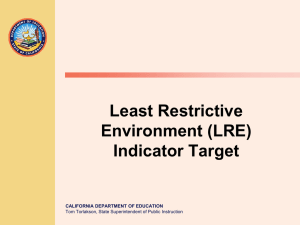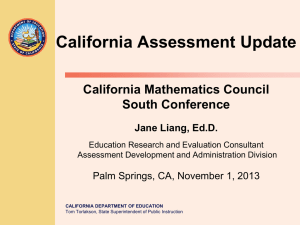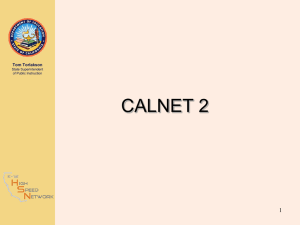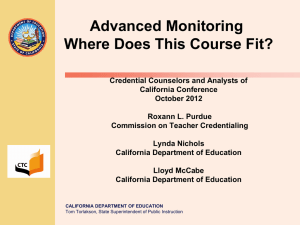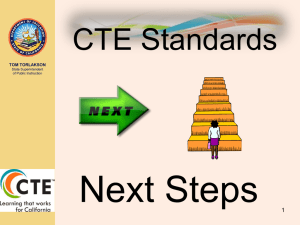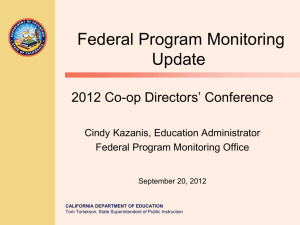An Overview of Response to Instruction and Intervention
advertisement
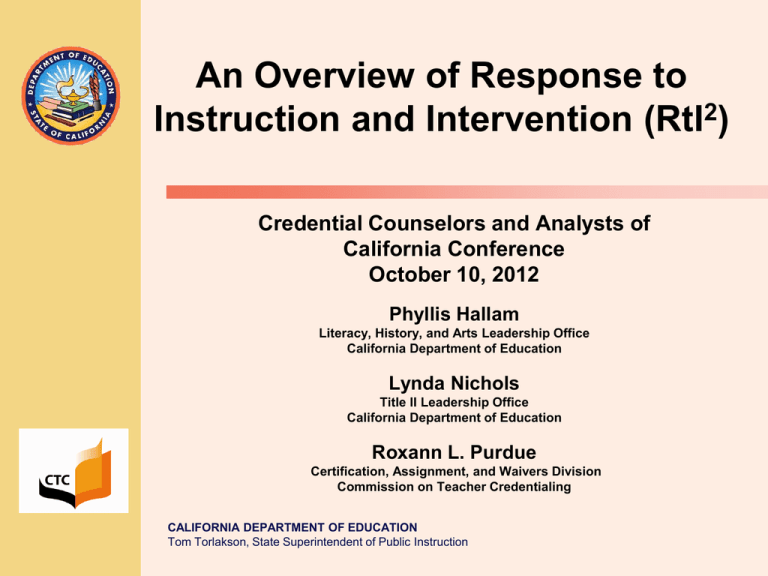
An Overview of Response to Instruction and Intervention (RtI2) Credential Counselors and Analysts of California Conference October 10, 2012 Phyllis Hallam Literacy, History, and Arts Leadership Office California Department of Education Lynda Nichols Title II Leadership Office California Department of Education Roxann L. Purdue Certification, Assignment, and Waivers Division Commission on Teacher Credentialing CALIFORNIA DEPARTMENT OF EDUCATION Tom Torlakson, State Superintendent of Public Instruction What is RtI2 and MTSS? TOM TORLAKSON State Superintendent of Public Instruction • Definitions o Response to Intervention and Instruction (RtI2) o Multi-Tier System of Supports (MTSS) • Background, goals and purpose • School-wide strategies • Considerations for planning • Roles and responsibilities 2 Definitions TOM TORLAKSON State Superintendent of Public Instruction RtI2 and MTSS integrate assessment and intervention in a general education, multi-level prevention system to maximize student achievement and to reduce behavior problems. – Identify students at risk for poor learning outcomes – Monitor student progress, provide evidence-based interventions – Adjust the intensity and nature of those interventions depending on a student’s responsiveness RtI2 – Identify students with learning disabilities or other disabilities and provide increased intervention 3 Background and Goals of RtI2 / MTSS • RtI first surfaced in the arena of special education. TOM TORLAKSON State Superintendent of Public Instruction • Districts and schools across the state began developing and implementing RtI2 independently. • The Special Education and Professional Learning Support Divisions of California Department of Education (CDE) organized the efforts around RtI2 in a task force that met from 2007–08 with results including: o CDE Curriculum and Resources RtI2 Web site o Ten Core Components o Implementation and Technical Assistance Guide • Both RtI2 and MTSS are based on a system of screening, progress monitoring, and data-based decision making for instruction and provide intervention in a timely manner to struggling students. 4 RtI2 Process TOM TORLAKSON State Superintendent of Public Instruction 5 INTENSIVE TOM TORLAKSON Tier III INTENSIVE Time Program Group Size State Superintendent of Public Instruction Tier II SBE Adopted Core Intervention Program STRATEGIC CORE + SUPPLEMENTAL Tier I BENCHMARK SBE-adopted CORE with Differentiated instruction 6 Additional Online Information CDE Web page http://www.cde.ca.gov/ci/cr/ri/ TOM TORLAKSON State Superintendent of Public Instruction 1. A Letter from State Superintendent Tom Torlakson 2. California's RtI2 Philosophy and Definition 3. Ten Core Components of RtI2 4. Resources by Ten Core Components 5. RtI2: An Implementation and Technical Assistance Guide for Districts and Schools 6. Brief: Staffing for RtI2 Academic Interventions The National Center on RtI Web site http://www.rti4success.org/ (Outside Source) 7 Why RtI2? TOM TORLAKSON State Superintendent of Public Instruction • The Individuals With disabilities Education Act 2004: authorized determining eligibility for Specific Learning Disabilities (SLD) using a research-based process such as RtI • Blueprint for Reform 2010 U.S. Department of Education, Elementary and Secondary Education Act: use of additional support and appropriate instruction to meet diverse needs • P-16 Council’s recommendations support RtI2 objectives • No Child Left Behind (NCLB) requirements of district mandate support for struggling students 8 A letter from former State Superintendent of Public Instruction Jack O’Connell states: TOM TORLAKSON State Superintendent of Public Instruction In a desire to close the achievement gap and meet federal and state requirements, many districts and schools are implementing the latest research-based practices that ensure students are successful in school. As a means to effectively utilize personnel, some special education teachers are being asked to instruct students with and without an Individualized Education Program (IEP). 9 CDE Letter Continued TOM TORLAKSON State Superintendent of Public Instruction If there are changes occurring in the manner of how instructional programs are delivered, including special education services, it is necessary that these practices remain compliant with federal and state laws and regulations. 10 CDE Letter Continued Use of Personnel and Funding TOM TORLAKSON State Superintendent of Public Instruction 1. Special education teachers must have the appropriate credentials to provide instruction to both students with an IEP and those students without IEPs. 2. Teachers must be highly qualified. Special education teachers providing instruction in the core academic subjects must meet the same "highly qualified" requirements and personnel qualifications described in the Individuals with Disabilities Education Act (IDEA) laws and regulations (EC Section 56058). 11 School-wide Strategies: A Comprehensive Instructional Approach Teachers work cooperatively to: TOM TORLAKSON State Superintendent of Public Instruction • Link instruction to student achievement • Emphasize good first teaching • Ensure all students receive initial academic screening • Implement progress monitoring which intensifies, depending on the need • Differentiate instruction per assessment results • Monitor student progress • Provide targeted academic and behavioral interventions if needed 12 Models of RtI2 and MTSS TOM TORLAKSON State Superintendent of Public Instruction • School-wide approach • District-wide approach • 3, 4, or more tiers framework 13 RtI Is TOM TORLAKSON State Superintendent of Public Instruction RtI is NOT • A general education activity • For Special Education only • A system to improve instruction for all students • A system for tracking • A school-wide approach that recognizes the importance of core curriculum instruction and interventions when needed • A single program for use by one or two teachers as desired • Only interventions • Only elementary • Only academics 14 What Does Intervention Look Like at the Site Level? TOM TORLAKSON • Tiered instruction and intervention provided by credentialed and non-credentialed adults • Targeted instruction that increases in intensity as needed for all students including English learners, struggling readers, or students with behavior issues or disabilities • Frequent progress monitoring • Collaborative problem solving around instruction • Flexibility in grouping • Exit criteria State Superintendent of Public Instruction 15 Consider the Case of Marty TOM TORLAKSON State Superintendent of Public Instruction No RtI2 or MTSS Model in Place •Marty has struggled in reading throughout school but always managed to show some progress. His family moved just before Marty entered 9th grade. •In 9th grade, he is reading at a 5th grade level and has little hope of leaving the non-proficient category in state testing. • His science and social studies grades are suffering as well. 16 The Case of Marty TOM TORLAKSON State Superintendent of Public Instruction • His 9th grade English teacher is considering a referral for special education. • By the end of 9th grade, he may be tested and placed into special education services, which will provide modifications and accommodations to his core curriculum throughout his 9-12 career. 17 RtI2/MTSS for Marty TOM TORLAKSON State Superintendent of Public Instruction • Using curriculum-based assessments, his teacher was able to identify specific areas of need in comprehension and Marty received supplemental instruction, 30 minutes a day, 5 days a week in an after school program. • By the end of 9th grade, Marty scored at grade level on oral reading fluency assessments and one grade below grade level on reading comprehension. • The school continues to monitor his progress through tenth grade to make sure he stays on track. Marty does not need special education services. 18 Considerations for Developing and Planning RtI2 and MTSS TOM TORLAKSON State Superintendent of Public Instruction • There is no one “right” way to implement the RtI2 and MTSS process. Each school or district develops its own plan. – What are existing policies within district that might affect implementation? – Do policies support process or do they need to be modified? – Are all teachers and paraprofessionals correctly credentialed to instruct academic areas? – Are the HR/Credential Analysts a part of the development process to ensure proper staffing issues are addressed? 19 RtI2/MTSS Planning Team: Who is at the Table? TOM TORLAKSON State Superintendent of Public Instruction May include but not limited to: • General Education Teachers • Special Education Teachers • Principal • Curriculum and Instruction Director • Psychologist • Speech Language Pathologist • Credential Analysts • Academic Improvement Director 20 RtI2 Roles and Responsibilities TOM TORLAKSON State Superintendent of Public Instruction Commission on Teacher Credentialing (CTC): • Teacher Preparation Programs • Credential Requirements • Authorizations • Appropriate Assignment 21 Staffing Considerations TOM TORLAKSON State Superintendent of Public Instruction Education Code (EC) §44225 states, among other responsibilities, that the Commission determines the scope and authorization of credentials and establishes sanctions for the misuse of credentials and the misassignment of credential holders. The Education Specialist Instruction Credential authorizes instruction to students identified through a valid IEP as needing instruction and services for specified federal special education disability areas. If an individual holds an Education Specialist teaching credential and does not also hold a multiple subject or single subject teaching credential, the individual is not authorized to independently teach general education students in a self-contained or departmentalized setting. 22 Staffing Considerations TOM TORLAKSON State Superintendent of Public Instruction Dual Credentialed Special Education Teachers: Individuals who hold special education credentials issued prior to 1997 are dual credentialed and were required to earn a general education teaching credential prior to earning the special education credential. There are current dual credential programs still offered with teachers electing to earn both general and special education teaching credentials. Note: NCLB approval for subject matter competence is not equivalent to an authorization or credential to serve. An individual must also hold a credential or authorization appropriate to the assignment and establish subject matter competency for the content area being taught. 23 Staffing Considerations TOM TORLAKSON State Superintendent of Public Instruction In relation to appropriate authorization and assignment, there are a variety of staffing options available to provide flexibility for the implementation of the multi-tiered intervention models uniquely developed at the local level. Collaboration (consultative content teaching, cooperative teaching)– In some models general or special education teachers visit the general education classroom and provide re-teaching and supportive strategies during regular classroom instructional time for the subject. These interventions include collaboration with the general education teacher of record and do not require the special education teacher to have an authorization to teach general education students. Co-Teaching (shared instructional responsibility, team teaching) - A classroom partnership or learning center model including both special education and general education credentialed teachers in order to meet the instructional needs of all students. These teachers combine their expertise and share responsibility in providing the instruction in a classroom or learning center with both general and special education students. The teachers have joint and equal responsibility for classroom instruction, planning and assessment. As this team of teachers carries a combination of authorizations for all of the students they jointly serve as the teachers of record, the special education teacher in this model would not need to hold an additional credential authorization to teach general education students. 24 Staffing Considerations TOM TORLAKSON State Superintendent of Public Instruction Study Skills/Strategies Local Assignment Option - In some cases, local education agencies indicate that their multi-tiered intervention models do not include specific content instruction but rather focus on learning strategies and skills. Local assignment option – This type of instructional model could be addressed with the use of a local assignment option in regulations. Title 5 section 80005(b) contains an authorization for teachers to be broadly assigned to provide instruction in areas that do not fall within the statutory single subject content areas – including courses in life skills, study skills, study hall, and others. Holders of a teaching credential based on a bachelor’s degree and a teacher preparation program including student teaching, who have been determined to have the knowledge and skills in the area, may serve in this type of assignment. Service is restricted to the grade level of the teaching credential. This local option does not require board authorization just teacher consent. Special Education Teachers - The language in this section of regulation does not preclude using a special education credential as the appropriate credential and may meet the needs of some multitiered intervention model settings not involving content instruction. 25 Staffing Considerations TOM TORLAKSON State Superintendent of Public Instruction Local Assignment Options for Content Based Interventions- California has many provisions within the Education Code that provide avenues for the assignment of certificated employees outside their basic credential authorization. These Education Code options provide school districts with local level flexibility for staffing. Most require specific units and local governing board action or resolution. Teacher consent to the assignment is required. Local Assignment Options must be annually documented and renewed if action by the local governing board is required. 26 Staffing Consideration Common Local Assignment Options TOM TORLAKSON State Superintendent of Public Instruction • §44258.3 allows local school districts to assign credentialed teachers to teach departmentalized classes in grades K-12 as long as the teacher’s subject-matter competence is verified according to policy and procedures approved by the governing board. • §44263 allows the credential holder to teach in a departmentalized class at any grade level if the teacher has completed eighteen semester units of course work, or nine semester units of upper division or graduate course work, in the subject to be taught. 27 Does a Teacher Need to Hold a Credential or Authorization? TOM TORLAKSON State Superintendent of Public Instruction Individuals need to hold the appropriate authorization prior to providing instructional services • EC §44001 • EC §44830(a) • EC §44831 • EC §44253.1 28 Intervention Classes TOM TORLAKSON State Superintendent of Public Instruction • Content of the class and authorization is determining factor for appropriate assignment • Type of class such as review, honors, intervention, or supplemental instruction is not a factor nor is the reason why the class is offered 29 Teacher on Special Assignment (TOSA) TOM TORLAKSON State Superintendent of Public Instruction • Local employment term • If assigned as a TOSA in instructional capacity, individual needs credential or authorization in subject area(s) • Information also applies to ‘resource teacher’ assignments 30 Special Education Credential Holders TOM TORLAKSON State Superintendent of Public Instruction Appropriate Assignment Special education credential holders are authorized to provide instruction in all academic subjects to students whose primary disability falls within the specialty area of their authorization. Note: Credential holder may be appropriately assigned but not be NCLB Compliant. 31 Special Education Credential Holders TOM TORLAKSON State Superintendent of Public Instruction Misassignment Special education credential holders including resource specialists are not authorized to provide instruction to general education students unless they also hold appropriate general education credential. Note: NCLB approval for subject matter competence is not equivalent to an authorization or credential to serve. An individual must also hold a credential or authorization appropriate to the assignment. 32 Special Education Services Credentials TOM TORLAKSON State Superintendent of Public Instruction • Speech Language Pathology (SLP) Services in Language, Speech, and Hearing without Special Class Authorization (SCA) • Authorized to provide speech therapy services • Not authorized to provide academic instruction to general or special needs students • Cannot teach reading or other content areas to general education or special needs students 33 SLP Credential Authorization TOM TORLAKSON State Superintendent of Public Instruction SLP Credential must include a SCA in order for the holder to provide academic instruction to special needs students. (Autism and Speech Language Impairment only) 34 Contact Information TOM TORLAKSON State Superintendent of Public Instruction Phyllis Hallam, Ph.D. Education Programs Consultant phallam@cde.ca.gov 916-323-4630 Lynda Nichols, Education Programs Consultant Title II Leadership Office lnichols@cde.ca.gov 926-323-5822 Roxann L. Purdue Certification, Assignment, and Waivers Division cawassignments@ctc.ca.gov 916-322-5038 35

